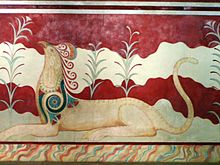Griffin
| Grouping | Mythological hybrids |
|---|---|
| Similar creatures | Hippogriff, Simurgh, Sphinx |
| Mythology | Ancient Egyptian, Persian, Renaissance |
| Other name(s) | griffon, gryphon |
The griffin, griffon, or gryphon (Greek: γρύφων, grýphōn, or γρύπων, grýpōn, early form γρύψ, grýps; Latin: gryphus) is a legendary creature with the body, tail, and back legs of a lion; the head and wings of an eagle; and an eagle's talons as its front feet. Because the lion was traditionally considered the king of the beasts and the eagle the king of birds, the griffin was thought to be an especially powerful and majestic creature. The griffin was also thought of as king of all creatures. Griffins are known for guarding treasure and priceless possessions.Adrienne Mayor, a classical folklorist, proposes that the griffin was an ancient misconception derived from the fossilized remains of the found in gold mines in the Altai mountains of Scythia, in present-day southeastern Kazakhstan, or in Mongolia, though this hypothesis has been strongly contested as it ignores pre-Mycenaean accounts. In antiquity it was a symbol of divine power and a guardian of the divine.
The derivation of this word remains uncertain. It could be related to the Greek word γρυπός (grypos), meaning 'curved', or 'hooked'. Also, this could have been an Anatolian loan word, compare Akkadian karūbu (winged creature), and similar to Cherub. A related Hebrew word is כרוב (kerúv).
Most statuary representations of griffins depict them with bird-like talons, although in some older illustrations griffins have a lion's forelimbs; they generally have a lion's hindquarters. Its eagle's head is conventionally given prominent ears; these are sometimes described as the lion's ears, but are often elongated (more like a horse's), and are sometimes feathered.
...
Wikipedia

